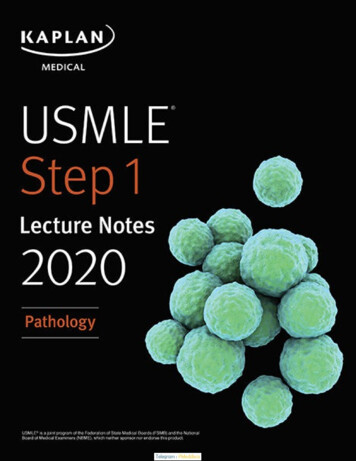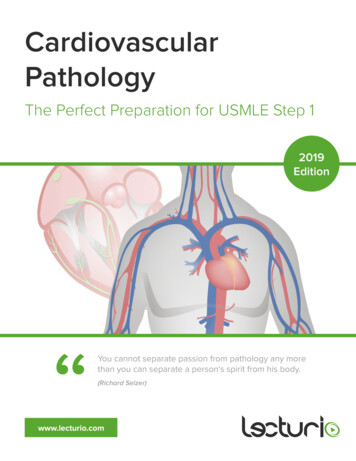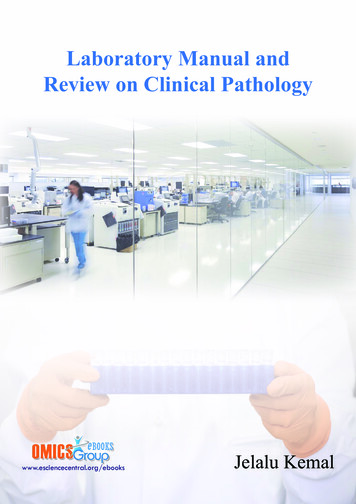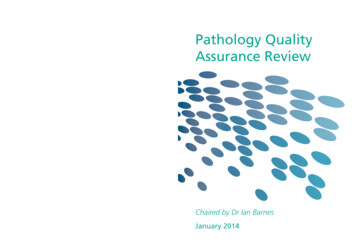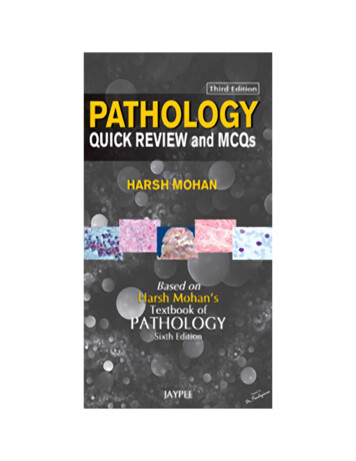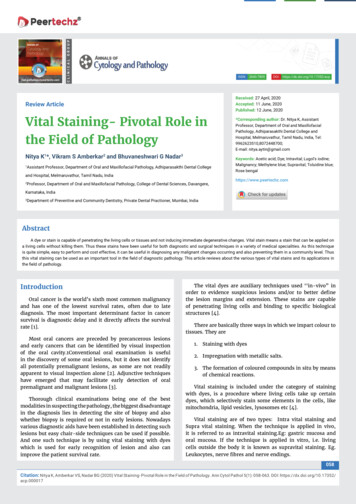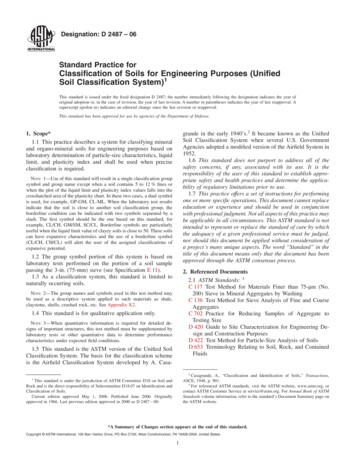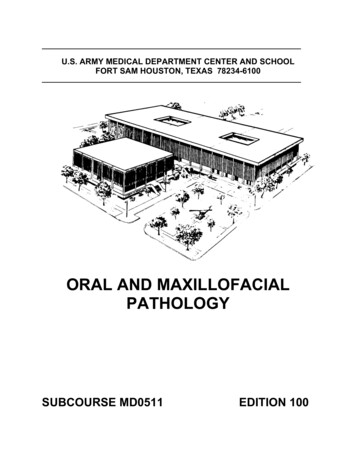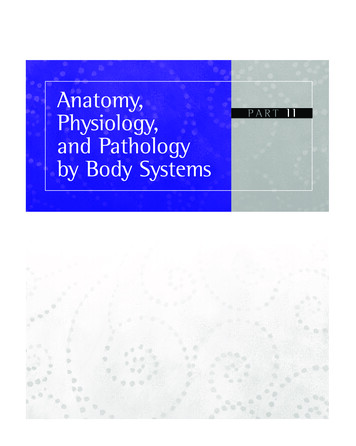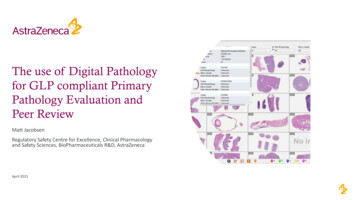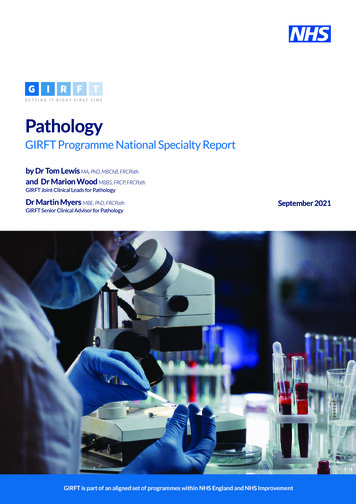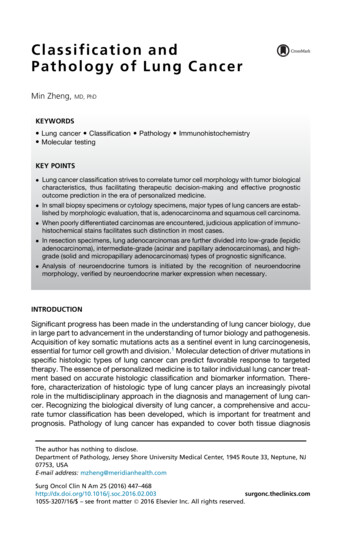
Transcription
Classification andPathology of Lung CancerMin Zheng,MD, PhDKEYWORDS Lung cancer Classification Pathology Immunohistochemistry Molecular testingKEY POINTS Lung cancer classification strives to correlate tumor cell morphology with tumor biologicalcharacteristics, thus facilitating therapeutic decision-making and effective prognosticoutcome prediction in the era of personalized medicine. In small biopsy specimens or cytology specimens, major types of lung cancers are established by morphologic evaluation, that is, adenocarcinoma and squamous cell carcinoma. When poorly differentiated carcinomas are encountered, judicious application of immunohistochemical stains facilitates such distinction in most cases. In resection specimens, lung adenocarcinomas are further divided into low-grade (lepidicadenocarcinoma), intermediate-grade (acinar and papillary adenocarcinomas), and highgrade (solid and micropapillary adenocarcinomas) types of prognostic significance. Analysis of neuroendocrine tumors is initiated by the recognition of neuroendocrinemorphology, verified by neuroendocrine marker expression when necessary.INTRODUCTIONSignificant progress has been made in the understanding of lung cancer biology, duein large part to advancement in the understanding of tumor biology and pathogenesis.Acquisition of key somatic mutations acts as a sentinel event in lung carcinogenesis,essential for tumor cell growth and division.1 Molecular detection of driver mutations inspecific histologic types of lung cancer can predict favorable response to targetedtherapy. The essence of personalized medicine is to tailor individual lung cancer treatment based on accurate histologic classification and biomarker information. Therefore, characterization of histologic type of lung cancer plays an increasingly pivotalrole in the multidisciplinary approach in the diagnosis and management of lung cancer. Recognizing the biological diversity of lung cancer, a comprehensive and accurate tumor classification has been developed, which is important for treatment andprognosis. Pathology of lung cancer has expanded to cover both tissue diagnosisThe author has nothing to disclose.Department of Pathology, Jersey Shore University Medical Center, 1945 Route 33, Neptune, NJ07753, USAE-mail address: mzheng@meridianhealth.comSurg Oncol Clin N Am 25 (2016) 03surgonc.theclinics.com1055-3207/16/ – see front matter Ó 2016 Elsevier Inc. All rights reserved.
448Zhengand selection of specific subtypes of lung cancers for further molecular testing. Confirmatory histologic diagnosis directs surgical resection of early-stage disease, whereaspathologic classification and molecular testing enable selection of tumor type–tailoredadjvuant therapy and genotype-based treatment regimen to improve the survivals ofadvanced-stage patients.Lung cancers are traditionally divided into non–small cell carcinoma (NSCC) andsmall cell carcinoma (small cell lung carcinoma, SCLC), with the former accountingfor 80% of the cases and the latter accounting for the remaining 20%. SCLCs behaveaggressively and are treated nonsurgically in most cases, whereas NSCCs aremanaged by a combination of surgery and adjuvant therapy. Recognition of the diversity of NSCC has led to its subclassification, culminating in the 2004 and 2015 WorldHealth Organization (WHO) classifications.2,3 Major types of NSCC include adenocarcinoma, squamous cell carcinoma (SSC), and large cell carcinoma (LCC). Thus, subtype of NSCC is specified, whereas the designation “NSCC” is only preserved incertain small biopsies and cytology specimens. SCLC is grouped with other tumorsexhibiting neuroendocrine differentiation. Since the publication of the last volume, significant update in lung cancer classification has occurred for lung adenocarcinomasbased on better understanding of tumor biology. This update is manifested by streamlined classification for small biopsies and cytology specimens, with special emphasison separating adenocarcinomas from the rest of the lung cancers in order to effectivelyscreen cases responsive to current mutation-driven therapeutic paradigms. Moredetailed histologic subtyping is used in resection specimens to delineate tissue typesof prognostic significance. This article discusses current pathologic classification oflung cancer, with an emphasis on updating readers to the new WHO lung adenocarcinoma classification (Box 1).3 This article thus serves as a springboard for effective surgical and medical treatment modalities discussed in other articles in this series.ADENOCARCINOMAAdenocarcinoma is the most common type of lung cancer, accounting for more than40% of lung cancers, 60% of the NSCC, and more than 70% of surgically resectedcases.3,4 The incidence of adenocarcinoma has risen steadily over the past fewdecades. Lung adenocarcinoma commonly forms a peripherally located mass withcentral fibrosis and pleural puckering. It can also have a variety of other gross appearances, including centrally located mass, diffuse lobar consolidation, bilateral multinodular distribution, and pleural thickening. By definition, lung adenocarcinoma is amalignant epithelial neoplasm with glandular differentiation or mucin production.When such morphologic features are recognized, the tumor can be designated asadenocarcinoma, even in small biopsy specimens. Lung adenocarcinoma cells usuallyexpress pneumocytic markers. Thyroid transcription factor (TTF-1) and NapsinA areexpressed in more than 85% of the lung adenocarcinoma cases and thus can serveas markers of adenocarcinoma or adenocarcinoma differentiation in poorly differentiated tumor and in limited biopsy sampling material (Fig. 1).5–7 Tumor classificationbased on ancillary tests such as immunohistochemistry (IHC) is designated as“NSCC, favor adenocarcinoma” in a small biopsy specimen. Resection specimensallow a more detailed subclassification. There has been significant refinement inadenocarcinoma classification in recent years based on close pathologic and clinicalcorrelation.3,8 The major histologic types have been validated to bear prognostic significance delineated by the tumor grade.9–14 Multiple gene alterations can occur in adenocarcinomas, with approved molecular targeted therapy available to improvepatient survival (see later disccusion).
Classification and Pathology of Lung CancerBox 1World Health Organization classification of lung cancerAdenocarcinomaLepidic adenocarcinomaAcinar adenocarcinomaPapillary adenocarcinomaMicropapillary adenocarcinomaSolid adenocarcinomaInvasive mucinous adenocarcinomaColloid adenocarcinomaFetal adenocarcinomaEnteric adenocarcinomaMinimally invasive adenocarcinomaSquamous cell carcinomaNeuroendocrine tumorsCarcinoid tumorsTypical carcinoidAtypical carcinoidSmall cell carcinomaLarge cell neuroendocrine carcinomaLarge cell carcinomaAdenosquamous carcinomaPleomorphic carcinomaSpindle cell carcinomaGiant cell carcinomaCarcinosarcomaPulmonary blastomaOther and unclassified carcinomasLymphoepithelioma-like carcinomaNUT carcinomaSalivary gland–type carcinomasMucoepidermoid carcinomaAdenoid cystic carcinomaEpithelial-myoepithelial carcinomaMesenchymal tumors, lymphohistiocytic tumors, tumors of ectopic origin, and metastatictumorsAdapted from Travis WD, Brambila E, Burke AP, et al. WHO classification of tumours of the lung,pleura, thymus and heart. 4th edition. Lyon (France): IARC Press; 2015.Preinvasive or Minimally Invasive AdenocarcinomaAdenocarcinoma in situ (AIS) represents relatively small sized tumors ( 3 cm) withneoplastic cells growing along preexisting alveolar structures (lepidic growth pattern)without evidence of stromal, vascular, or pleural invasion. Lepidic is a descriptive termfor rind or membranous growth pattern and is now specifically used to describe tumorcells proliferating along the surface of intact alveolar walls.15 Lepidic growth usuallycorrelates with ground glass opacity on radiograms. Most AISs are the nonmucinoustype, with mild to moderate pleomorphic cuboidal to columnar tumor cells linearly lining alveolar walls. There is no secondary papillary or micropapillary growth pattern. A449
450ZhengFig. 1. Adenocarcinomas. (A) Lepidic adenocarcinoma (H&E, original magnification 200).(B) Acinar adenocarcinoma (H&E, original magnification 200). (C) Papillary adenocarcinoma (H&E, original magnification 100). (D) Micropapillary adenocarcinoma (H&E, original magnification 200). (E) Solid adenocarcinoma (H&E, original magnification 100).(F) Solid adenocarcinoma (TTF-1 stain, original magnification 100).minority of such tumors are of mucinous or mixed type. If the tumor contains a smallfocus ( 5 mm) of invasive growth, the tumor is classified microinvasive adenocarcinoma (MIA). Invasion usually induces formation of a desmoplastic stroma. Invasioncan also manifest as nonlepidic growth, such as acinar, papillary, micropapillary, orsolid patterns. MIA is defined not only by limited size invasive growth but also by alack of more advanced invasive pattern, such as tumor necrosis, lymphovascular invasion, and pleural invasion. Both types of tumor are low grade and have a nearly100% 5-year survival rate.3Invasive AdenocarcinomaMost invasive adenocarcinomas are composed of mixed morphological subtypes;these are classified according to the predominant architectural structures ratherthan lumped together as mixed subtype. Each tumor is classified according to onepredominant growth pattern, including lepidic, acinar, papillary, micropapillary, andsolid patterns (see Fig. 1). Each additional subpattern is recorded semiquantitativelyas estimated percentage in 5% increments.3,8 This architectural-driven classificationhas prognostic significance, with most favorable prognosis for lepidic-predominantadenocarcinomas, intermediate survival rate for acinar and papillary predominant adenocarcinomas, and poor prognosis for solid and micropapillary predominantadenocarcinomas.11,12,16Lepidic AdenocarcinomaLepidic growth is commonly seen in lung adenocarcinoma. The lepidic growth patterndenotes tumor cells spreading along preexisting alveolar structures, although theremay be sclerotic thickening of alveolar septa. When it is the predominant growthpattern with additional findings that set it apart from previously described AIS andMIA, it is designated as lepidic adenocarcinoma. These additional findings includeany one or more of the following: more than 5 mm of invasion (presence of desmoplastic or myofibroblastic stroma); spread through air spaces; lymphatic or vascular
Classification and Pathology of Lung Cancerinvasion; pleural invasion; tumor necrosis. Although such tumors were previously classified as bronchioloalveolar carcinoma, this term is no longer used because it encompasses a heterogeneous group of adenocarcinomas. This category convenes asignificantly better prognosis than other subtypes.3Acinar AdenocarcinomaAcinar adenocarcinoma is a common type of adenocarcinoma with tumor cells arranged in classic glandular structure on a fibroelastic stroma. It is important to separate demosplastic stroma in this pattern from preexisting alveolar structures withthickened fibroelastic alveolar septa sometimes seen in a lepidic pattern. It is ofnote that the tumor cells displaying more complex growth patterns, such as a cribriform pattern, likely represent a poor prognostic subtype convening a significant riskof recurrence.17Papillary AdenocarcinomaThe tumor cells form papillary architecture with tumor cells lining the surface ofbranching fibrovascular cores. The presence of fibrovascular cores separates this tumor type from micropapillary adenocarcinoma.Micropapillary AdenocarcinomaThe tumor cells form individual cellular tufts without fibrovascular core. The tumor cellsappear as detached small and solid individual cell groups. Psammoma bodies may beseen. This subtype of adenocarcinoma has distinctly poor prognosis in the early stagecompared with other subtypes of adenocarcinoma.18–20Solid AdenocarcinomaThe tumor cells form patternless sheets and lack any other recognizable patterns,including poorly differentiated/undifferentiated carcinomas expressing pneumocyticmarkers (such as TTF-1 and NapsinA), which were formerly grouped in the LCC category.3 It is of note that certain markers commonly associated with squamous cell differentiation, such as p63, and less commonly, p40, can show focal expression in solidadenocarcinoma.3,21Rare Variants of Invasive AdenocarcinomaRare variants of invasive adenocarcinoma include invasive mucinous adenocarcinoma, colloid and fetal adenocarcinoma, and enteric adenocarcinoma. Invasivemucinous adenocarcinoma is frequently multicentric and the tumor cells lack expression of TTF-1 commonly seen for lung adenocarcinoma.22 Enteric adenocarcinomashould be distinguished from metastatic colorectal adenocarcinoma.23SQUAMOUS CELL CARCINOMASCCs make up about 20% of lung cancers.4 Their incidence has declined in recent decades, likely because of changes in smoking behavior. SCC usually occurs in the central portion of the lung, along major airways, and can form cavities when it achieves alarge size. On microscopic examination, SCC characteristically shows keratinizationand intercellular bridges and exhibits a solid nested growth pattern (Fig. 2). The tumorcells usually have hyperchromatic nuclei, visible to inconspicuous nucleoli, and moderate to abundant cytoplasm with delineated intercellular bridges. There can be individual tumor cell keratinization or groups of keratinizing squamous cells formingkeratin pearls centrally placed within solid tumor nests. The tumor cells lack glandular451
452ZhengFig. 2. SCC. (A) Keratinizing SCC with keratin pearl formation (H&E, original magnification 200). (B) Intercellular bridge formation (H&E, original magnification 400). (C) Nonkeratinizing SCC without apparent keratinization or discernible intercellular bridges (H&E, original magnification 400). (D) Tumor cells stain positive for p40 (nuclear stain) (p40 stain,original magnification 400).structure or mucin production. SCCs are further divided into keratinizing, nonkeratinizing, and basaloid subtypes. Contrary to adenocarcinoma subtypes, such subclassification shows no apparent prognostic utility except for basaloid SCCs, whichreportedly display distinct molecular profile conferring intrinsic resistance to cytotoxicchemotherapy.24 Recognizing morphologic features of squamous cell differentiation,including keratinization, keratin pearl formation, and intercellular bridges, establishesSCC diagnosis, even in small biopsy specimens. When the tumor is poorly differentiated and does not allow confident morphologic classification, selective squamous cellmarkers, such as p40, CK5/6, CK5, and p63, are used to demonstrate squamous differentiation (see Fig. 2).25 TTF-1 stain is usually negative, although focal weak positivestain for this marker has been reported.26 Poorly differentiated tumor defined byexpression of squamous cell markers in a biopsy material is diagnosed as “NSCC, favorSCC.” Although tumors in this category are usually excluded from current moleculartesting, identification of driver mutations in SCC, such as discoidin domain receptor 2(DDR2), phosphatidylinositol-4,5-bisphosphate 3-kinase catalytic subunit alpha(PI3KCA), fibroblastic growth factor receptor 1 (FGFR1), and v-akt murine thymomaviral oncogene homolog 1 (AKT1), may enable future personalized therapy.27 Establishment of squamous cell differentiation has important implications in chemotherapeuticagent choices so as to avoid certain complications. For instance, treatment with thevascular endothelial growth factor inhibitor bevacizumab in patients with SCC canpotentially precipitate life-threatening pulmonary hemorrhage, and therefore, shouldbe avoided.28,29 Survival rate for SCC is significantly better than adenocarcinoma.
Classification and Pathology of Lung CancerLARGE CELL CARCINOMALCCs represent a minority of NSCC cases that are devoid of lineage-specific differentiation, and lack morphologic and immunohistochemical evidence of adenocarcinoma, SCC, or neuroendocrine carcinoma (null immunophenotype). LCC is usuallyperipherally located, bulky, and necrotic in appearance. The tumor cells are largeand polygonal in shape with pleomorphic and vesicular nuclei. The tumor cells formpatternless solid sheet or nests. Large cell neuroendocrine carcinoma (LCNEC) isclassified in the lung neuroendocrine tumor (NET) category (see later discussion).LCCs represent less than 3% of the lung cancers.4,23 Tumors with morphologic characteristic of LCC are designated as “NSCC, not otherwise specified (NOS)” in a biopsyor cytology material, not LCC, because the latter can only be ascertained in a resection specimen with the thoroughly analyzed tumor devoid of lineage-specific differentiation.3,5 It is important to apply ancillary tests such as IHC to avoid inclusion of poorlydifferentiated NSCC, such as solid adenocarcinoma and nonkeratinizing SCC, in thiscategory. In fact, most LCCs defined by morphologic criteria can be reclassified asadenocarcinoma and SCC using a panel of lineage-specific markers.30–32 Effectiveapplication of such ancillary tests is the likely explanation for the decline of lung cancers categorized as LCC in recent years.3 Recent evidence suggests that tumorscurrently classified as LCC with null immunophenotype share molecular characteristics similar to solid adenocarcinoma.33 Tumors in this category are not necessarilyexcluded from molecular testing. Metastatic tumors should be excluded in appropriate clinical context. Most LCC cases have adverse outcome, especially for thosewith null immunophenotype.34OTHER NON–SMALL CELL CARCINOMA TYPESAdenosquamous carcinoma is a rare type of NSCC, accounting for less than 5% ofall lung cancers.35 It represents a hybrid carcinoma containing both adenocarcinomaand SCC components, with each comprising at least 10% of the tumor.2,3 From aclinical prospective, adenosquamous carcinoma is usually included in the discussionof adenocarcinomas because therapeutically important mutations occur in adenosquamous carcinoma in similar frequency as in conventional adenocarcinoma36;this is especially significant in light of its worse prognosis than that of adenocarcinoma and SCC.37–39Pleomorphic, spindle cell, and giant cell carcinomas are rare types of NSCC,accounting for less than 3% of lung cancers.3 These tumors demonstrate spindleand/or giant cell differentiation (sarcoma-like differentiation). Such tumors can beascertained only in resection specimens. In biopsy specimens, tumors with suchfeatures are reported as “NSCC with spindle and/or giant cell carcinoma.”3,8Expression of cytokeratin is important in this setting to exclude a primary pulmonary sarcoma. Because some tumors can show weak or even absent expressionof common epithelial markers, multiple anticytokeratin antibodies may be necessary. Epithelial markers commonly used include pancytokeratin, cytokeratin AE1/AE3, CK7, and EMA. Such tumors have a worse prognosis than conventionalNSCC.40Carcinosarcoma is composed of NSCC and sarcomatous elements, such as rhabdomyosarcoma, chondrosarcoma, and osteosarcoma.3 Pulmonary blastoma must bedistinguished from pleuropulmonary blastoma occurring in the pediatric population.41Carcinomas can rarely arise from bronchial glands, analogous to salivary gland tissue.Major histologic types include mucoepidermoid carcinoma, adenoid cystic carcinoma, and epithelial-myoepithelial carcinoma.3453
454ZhengNEUROENDOCRINE TUMORSNETs as a group are relatively common lung tumors, accounting for about 20% to 25%of lung cancers.42,43 Their common morphologic, immunohistochemical, and ultrastructural features set them apart from other lung tumors. These features include organoid growth pattern, finely granular or “salt-and-pepper” chromatin pattern, and theexpression of several hallmark neuroendocrine markers. Common neuroendocrinemarkers include chromogranin A, synaptophysin, and CD56. Within this group of tumors, there is a heterogeneous degree of differentiation, with well-differentiated tumorsretaining most or all of the above characteristics and poorly differentiated tumors losingsome or most of the discernible neuroendocrine differentiation features. This histologicdifferentiation is epitomized by tumor proliferation rate, which in turn correlates with tumor aggressiveness and prognosis. The 2015 WHO classification separates this groupof tumors into 4 major categories, including typical carcinoid, atypical carcinoid, smallcell carcinoma (or SCLC), and LCNEC (Table 1).3 Because tumor cell proliferation ratehas been shown to provide accurate overall prognostic information, this has been usedalong with the presence or absence of necrosis to divide NETs into 3 grades of prognostic significance.44–46 The low-grade NET corresponds to typical carcinoid;intermediate-grade NET corresponds to atypical carcinoid, and high-grade NET corresponds to SCLC and LCNEC. The proliferation rate is expressed as the number of mitoses per microscopic unit area of tumor (usually defined as mitoses per 2 mm2 or 10high-magnification microscopic fields). In recent years, utilization of Ki67 labeling indexas an adjunct for grading has gained popularity.47–49 This Ki67 labeling index is especially useful in evaluating small biopsy specimens, whereby it is often impossible tocount adequate microscopic fields to give an accurate reflection of proliferation rate.Typical CarcinoidCarcinoid tumors are rare, accounting for 1% to 2% of all lung tumors.48 In the pediatric population, however, carcinoid tumors represent a common tumor type.50,51Table 1Diagnostic findings in neuroendocrine tumorsAtypicalTypical Carcinoid CarcinoidSCLCLCNECNeuroendocrinemorphologyLarge cell size,Monotonous cells Monotonous cells Small cell size,frequentfinely granulararranged inarranged inpresence nesting,nesting,abundantnucleoli, ttes,rosettes,trabeculaetrabeculaeMitoses per2 mm2 22–10 10, usually 60 10, usually 30Ki67 proliferation 4–5%index 20–25% 50%Usually 40%NecrosisNoFocal orpunctuateOften extensively Often ssionYesYesYes, rarelynegativeYesGradeLow gradeIntermediategradeHigh gradeHigh grade
Classification and Pathology of Lung CancerTypical carcinoids are different from other types of lung cancers in their presentation ata relatively younger age (mean age range at presentation 45–55 years) and morefrequent presentation at an earlier stage (more than 70% of the cases present as stageI disease), as well as good prognosis (more than 90% 5-year survival rate).52 There isno direct association with smoking because the prevalence of smoking in patientsdiagnosed for typical carcinoid is similar to the general population.53 Carcinoid syndrome is rarely present, unless there is liver metastasis.54 Carcinoid tumors occur inabout 5% of patients with multiple endocrine neoplasia type 1, although most casesoccur as nonfamilial (sporadic) isolated tumors.55Typical carcinoids display characteristic morphologic features attributable to neuroendocrine differentiation. The tumor cells are generally small in size and uniform inshape. The chromatin pattern is usually fine or coarse granular without apparentnucleoli. There is a moderate amount of eosinophilic staining cytoplasm, which keepsindividual tumor cell nuclei a uniform distance from one another. The tumor cells aretypically arranged in organoid nests, with variation of trabeculae, insular, ribbon,and rosettelike arrangements (Fig. 3). Some typical carcinoids have spindle cellfeatures with fusiform cells arranged in a fascicular pattern. By definition, typicalcarcinoids have a low proliferation rate, less than 2 mitoses per 10 high power fields.Ki67 (or MIB-1) labeling index is usually less than 4% to 5%.49 There is no tumornecrosis. Typical carcinoid expresses common neuroendocrine markers such as synaptophysin, chromogranin, and CD56.Atypical CarcinoidSimilar to typical carcinoids, atypical carcinoids are relatively common in the youngerage group compared with other types of lung cancers and are frequently presented asearly-staged disease.48 The prevalence of smoking in patients diagnosed for atypicalcarcinoids is twice as high as the general population. The prognosis of atypicalFig. 3. NETs. (A) Typical carcinoid with organoid cell nests (H&E, original magnification 400). (B) Typical carcinoid with positive staining for synaptophysin (synaptophysinstain, original magnification 400). (C) Typical carcinoid with less than 4% Ki67 labeling index (Ki67 stain, original magnification 400). (D) Atypical carcinoid with organoid cell nests(H&E, original magnification 400). (E) Atypical carcinoid with positive staining for synaptophysin (synaptophysin stain, original magnification 400). (F) Atypical carcinoid withgreater than 4% Ki67 labeling index (Ki67 stain, original magnification 400).455
456Zhengcarcinoid is significantly lower than typical carcinoid, with 5-year overall survival rateless than 80%.56Atypical carcinoids have cytomorphological features similar to typical carcinoids, although tumor cells in atypical carcinoids tend to display more cytologicatypia (see Fig. 3). The defining features of the atypical carcinoids are an intermediate proliferation rate and/or the presence of tumor necrosis. Atypical carcinoidshave an intermediate rate of mitosis, between 2 and 10 mitoses per 2 mm2.3Ki67 or MIB-1 labeling index is usually less than 20% to 25%.46,49 Evaluation ofKi67 labeling index can be important in a small biopsy material to avoid overdiagnosing atypical carcinoids as high-grade neuroendocrine carcinomas.47 Tumor necrosis is focally present, usually punctuate, and less than 10% of the tumorvolume.49Small Cell CarcinomaSmall cell carcinomas or SCLCs comprise slightly more than 10% of all lung cancers.4,57 Smoking history is present in virtually all cases of SCLC.4 SCLC is a highlyaggressive malignancy. Patients usually have metastatic disease at the time of presentation. Most patients relapse within the first 2 years after treatment and the2-year survival rate is less than 10% in metastatic patients.58 SCLC is commonly centrally located in the major airway. SCLC has distinct morphologic features and carefulevaluation on the routine hematoxylin and eosin (H&E)-stained section affords a highaccuracy of diagnosis. The tumor cells are small in size compared with other types oflung cancers, usually less than the diameter of 3 mature lymphocytes. The chromatinis finely granular without prominent nucleoli. The cytoplasm is scanty, and the cellularborders are inconspicuous (Fig. 4). There is a high mitotic rate, usually greater than 10mitoses per 2 mm2. There is also a high apoptotic rate and frequent presence ofFig. 4. Neuroendocrine carcinomas. (A) Small cell carcinoma (SCLC) with small-sized nucleiand scanty cytoplasm (H&E, original magnification 400). (B) SCLC with positive stainingfor synaptophysin (synaptophysin stain, original magnification 400). (C) SCLC with greaterthan 80% Ki67 labeling index (Ki67 stain, original magnification 400). (D) LCNEC withlarge-sized cells and tumor necrosis (H&E, original magnification 400). (E) LCNEC with positive staining for synaptophysin (synaptophysin stain, original magnification 400). (F)LCNEC with greater than 40% Ki67 labeling index (Ki67 stain, original magnification 400).
Classification and Pathology of Lung Cancerextensive tumor necrosis. In bronchial biopsy material, there is frequent crush artifact.In core needle biopsy or surgical biopsy specimen, there is usually greater nuclear sizevariation and less crush artifact. The tumor cells form organoid nests or diffusesheets. The diagnosis is based on light microscopy using routine H&E-stainedslides. In small biopsy material with significant crush artifact, IHC can be very helpful in establishing the diagnosis and in excluding other morphologic mimics.Commonly used stains include pankeratin and neuroendocrine markers (CD56,chromogranin, synaptophysin), although their expression levels are usually lowerthan low- to intermediate-grade NETs. An exception is TTF-1, which is expressedin close to 90% of SCLC.59,60 High Ki67 (MIB-1) labeling index ( 50%, usually70%–100%) is a hallmark of SCLC, which helps to distinguish it from low- andintermediate-grade NETs to avoid overdiagnosing the latter in small crushed biopsyspecimens.47,49 Cytology is extremely useful and can offer a higher yield of diagnosis than small biopsies with scant intact, viable tumor cells. WHO classificationdivides SCLC into 2 subtypes: pure SCLC and combined SCLC containing acomponent of NSCC.Large Cell Neuroendocrine CarcinomaLCNEC, like SCLC, is associated with heavy smoking history.4 It is usually peripherallylocated in the lung. LCNEC is a highly aggressive neuroendocrine carcinoma. As itsname implies, the tumor cells are larger than SCLCs and they have abundant cytoplasm (see Fig. 4). Other common features include polygonal cell shape, frequentpresence of nucleoli, and low nuclear-cytoplasmic (N:C) ratio.61 Importantly, there isdiscernible neuroendocrine architecture, including organoid arrangement, trabeculargrowth, and rosettelike structures. There is a noticeable absence of cellular architectures commonly associated with adenocarcinoma differentiation. Like SCLC, thesetumors show high mitotic rate ( 10 mitoses per 2 mm2) and conspicuous tumor necrosis. Immunohistochemical stains play an important ancillary role. There should beexpression of at least one neuroendocrine marker. It is of note that the diagnosis ofLCNEC is based on a combination of the above features. Specifically, the diagnosisis not relied solely on immunohistochemical expres
sity of NSCC has led to its subclassification, culminating in the 2004 and 2015 World Health Organization (WHO) classifications. 2,3 Major types of NSCC include adenocar- cinoma, squam
